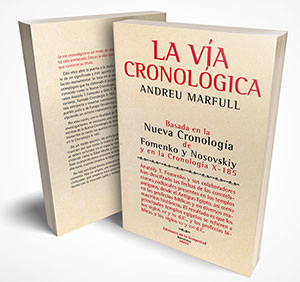
Anatoly T. Fomenko and his collaborators have deciphered the dates of the zodiacal constellations present in ancient temples, from Ancient Egypt, as well as in Biblical prophecies and in various historical manuscripts. The result is that the main Egyptian temples refer to the 12th to 15th centuries AD, and the Biblical prophecies refer to the 15th and 16th centuries AD.
© Andreu Marfull Pujadas
© of this edition: Ediciones de La Tempestad SL, 2020
Barcelona, May 2020
ISBN 978 84 121768 1 0
SYNOPSIS
The chronological route is a way of delving into a reality that has been taken from us. This is the idea that embraces this book, and the message that contains its title.
This work opens the door to the doubt of the veracity of history, gives it a meaning and it points to an unquestionable monumental manipulation. It is based on the temporal compression of the chronological map produced by the scientific research project known as the New Chronology, led by Russian mathematicians Anatoly T. Fomenko and Gleb V. Nosovskiy. But it introduces a variant, called X-185 timeline, that complements it. This line interprets and solves central questions for the stories of the Jewish people and of Western Europe that the New Chronology treats following an exploratory criterion that can be developed.
For this reason, in order to facilitate the debate between the two investigations, an exhaustive synthesis of the foundations of the New Chronology of Fomenko and Nosovskiy is incorporated, and, in addition, the reason, the points in common and the results obtained in the X-185 timeline.
In a succinct way, the main results of this reconstruction are that both the official history and the sacred texts ought to be understood in the temporal space that common sense understands as the Middle Ages, and it ends in the 17th century. Everything that happened until then must be questioned. It is in the 17th century that European colonial hegemony begins, not before.
There is no millennial Middle Ages between Antiquity and the Renaissance. There is an origin, an evolution and various crises in the civilizing process, which began a thousand years ago in Egypt, and is transformed with the Jewish and Mongolian incursion.
SUMMARY
FOREWORD
Thanks to
INTRODUCTION
The scientific doubt that falls on traditional dating methods
Study topic and method
PART ONE: THE MANIPULATION
INH's contribution to historical reconstruction
The (provisional) contribution of an alternative chronology to the INH's historical research
How and when to understand the Spanish Golden Age
Two ways of understanding chronological manipulation
The historical journey of criticism of the chronological map
The invention of the past
The case of the Hispanic Era
The modern origin of the Italian Roman Empire
Large scale documentary forgery
The case of the Spanish documentary forgery
Academic contempt for his own work
The archaeological forgery of the 19th and 20th centuries
SECOND PART: THE CONSCIOUSNESS
The alteration of historical consciousness
The fantasy generated by a long human history
Towards a new chronological paradigm
The problem of positivist historicism
Written history is a molded narrative, but is hardly recognized
The (subtle) critique of historicism
The contribution of Karl Marx
Managing (un)conscious manipulation
The symbolic capital (power) of written history
The violence of historical unconsciousness
Historical revisionism
PART THREE: THE METHODS
How to understand the reading of a double interpretation
The New Chronology of Fomenko and Nosovskiy
What is the New Chronology
How to approach the reconstruction of global history
The origin of the New Chronology
The scientific basis of the New Chronology
Dating methods based on Astronomy analysis
Dating methods based on statistical analysis
The main axes of the construction of history, and its subsequent reconstruction
The communion of the pyramids of Egypt, Eurasia and America
The history of religions
The sacred texts of the original story
The resulting story, very brief
The X-185 timeline
Origin of the X-185 timeline
The alternative history, very summarized
New agents
New patterns
555 years that are three jumps of 185
The Judaic X-260 variant
The meaning of Christ
The great biblical and medieval struggle, Jewish, Tatar and Mongolian
PART FOUR: THE ALTERNATIVE HISTORY
Preface 1: The Egyptian Tales and the Mystery of Tutankhamun
The castaway's tale
The tale of Setme II
Other tales
Tutankhamun's story
Preface 2: EL BECERRO general
The identity of the author of the manuscript
The owner of the manuscript
The sections of the manuscript
Evidence of the invention of the history of the Aragon Crown
The eastern powers of Alba and Portugal, Castile, Galicia, Biscay and half of Europe
Prester John and a marriage
The tomb of Saint Thomas, Genghis Khan or Alexander the Great
The marriage of an Indian princess with a Christian religious, from "royal blood"
Mary Magdalene, of royal blood
Constantine and Helena
The Merovingian Mary Magdalene
The Ark of the Covenant
Solomon's Temple
The Holy Sepulcher of Jerusalem
The Judaism
Jewish lace in alternative history
Occitan Judaism
From inter-religious disputes to the Messianic Christ
The discovery of America
Reconstruction of the hidden reasons of colonial history
The reconstruction of the powers of Castile and the destruction of the Catalans
Christopher Columbus, Hernán Cortés and the Laskaris Komnenos
Las Laskaris Komnenos today
The transition of powers from the East to Europe
The mutation of Russia
The mutation of Spain
The archival and documentary mutation
EPILOGUE
The tragedy
The beauty
ANNEXES
Annex 1. Tables of genealogical equivalences of the New Chronology of Fomenko and Nosovskiy
Annex 2. Charts of the New Chronology of Fomenko and Nosovskiy
Annex 3. Detail of the manuscript “EL BECERRO general”
Bibliography cited